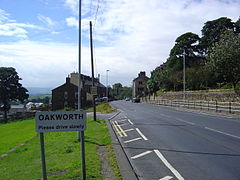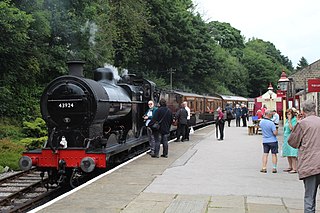
The Keighley & Worth Valley Railway is a 5-mile-long (8 km) heritage railway line in the Worth Valley, West Yorkshire, England, which runs from Keighley to Oxenhope. It connects to the National Rail network at Keighley railway station.

Haworth is a village in the civil parish of Haworth and Stanbury, in the Bradford district, in the county of West Yorkshire, England, in the Pennines, 3 miles (5 km) south-west of Keighley, 10 miles (16 km) west of Bradford and 10 miles (16 km) east of Colne in Lancashire. The surrounding areas include Oakworth and Oxenhope. Nearby villages include Cross Roads, Stanbury and Lumbfoot.

Oxenhope is a village and civil parish near Keighley in the metropolitan borough of Bradford, West Yorkshire, England. It was historically part of the West Riding of Yorkshire. The population was 2,476 at the time of the 2001 census which had increased to 2,626 at the 2011 Census. Oxenhope railway station is the terminus for the Keighley and Worth Valley Railway.

Keighley is a market town and a civil parish in the City of Bradford Borough of West Yorkshire, England. It is the second largest settlement in the borough, after Bradford.

Oakworth Hall is located in Oakworth, West Yorkshire, England. The manor house was rebuilt in the 17th century, but has a history dating back to 1066. The building overlooks the Worth Valley, facing south towards Haworth.
George Robert Cryer was an English Labour Party politician from Yorkshire. He sat in the House of Commons of the United Kingdom as the Member of Parliament (MP) for Keighley from 1974 until his defeat in 1983. He then served as the Member of the European Parliament (MEP) for Sheffield from 1984 to 1989, and returned to the Commons as MP for Bradford South from 1987 until his death in 1994.

Sir Isaac Holden, 1st Baronet was an inventor and manufacturer, who is known both for his work in developing the Square Motion wool-combing machine and as a Radical Liberal Member of Parliament.

Oldfield is a small hamlet within the county of West Yorkshire, England, situated north of Stanbury and near to Oakworth. It is approximately 6 miles (9.2 km) west of the town of Keighley. It mainly consists of farmland and has panoramic views across the Worth Valley towards Brontë Country. Top Withens, the house featured in the novel Wuthering Heights, is clearly visible.

Ingrow is a suburb of Keighley, West Yorkshire, England that lies on the River Worth. The name Ingrow comes from Old Scandinavian which means 'corner of land in the meadow.' The suburb is located on the A629 road and is 0.93 miles (1.5 km) south west of Keighley town centre.
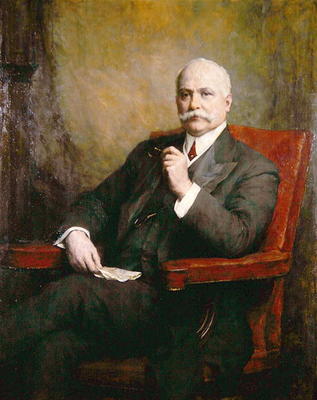
There have been three baronetcies created for persons with the surname Holden, all in the Baronetage of the United Kingdom. Two of the creations are extant as of 2010.
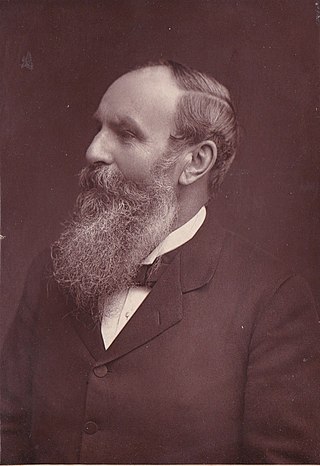
Angus Holden, 1st Baron Holden, was a British Liberal Party politician who was active in local government and sat in the House of Commons in two periods between 1885 and 1900. He was raised to the peerage as Baron Holden in 1908.

Holden Park is the only park in the village of Oakworth, West Yorkshire, England. The park is also known locally as Oakworth Park.

Oakworth Railway Station serves the village of Oakworth, near Keighley, and within the City of Bradford Metropolitan District, West Yorkshire, England.

Haworth railway station serves the village of Haworth in West Yorkshire, England.

The Railway Children is a 1970 British family drama film based on the 1906 novel of the same name by E. Nesbit. The film was directed by Lionel Jeffries and stars Dinah Sheridan, Jenny Agutter, Sally Thomsett and Bernard Cribbins in leading roles. The film was released to cinemas in the United Kingdom on 21 December 1970.
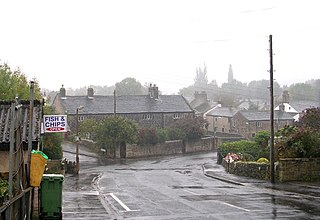
Utley is a village that forms a suburb of the town of Keighley within the county of West Yorkshire, England, approximately 1.5 miles (2.4 km) from the town centre.
Keighley Tramways Company operated a tramway service in Keighley between 1889 and 1901 with horse power. The system re-opened three days later as Keighley Corporation Tramways and stayed in service until 1924 when it closed for good.

Laycock is a small village in the Bradford District of West Yorkshire that overlooks the hamlet of Goose Eye. The village is 1.9 miles (3 km) west of the town of Keighley and 1.2 miles (2 km) north of Oakworth village. The village is in the council ward of Keighley West.

Hainworth is a hamlet 1 mile (2 km) south of Keighley in West Yorkshire, England. The hamlet faces north across the lower end of the Worth Valley with a steep wooded incline towards Keighley.

The Worth Valley is a geographic area in West Yorkshire, England, that extends eastwards from Crow Hill and Oxenhope Moor, providing drainage for the River Worth for nearly 10 miles (16 km) to the River Aire. It is a side valley to Airedale, with the River Worth being a major tributary of the River Aire. The Worth Valley was important for its contribution to the textiles industry of the West Riding of Yorkshire and was furnished with several reservoirs to allow mills to operate within the valley. Most of the reservoirs are still in use into the modern day.
